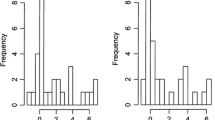Abstract
In publicly funded health care systems decisions have to be taken about whether or not pharmaceuticals should be reimbursed and included in the budget-constrained public insurance system. Within this context, an iterative framework could be used to distinguish the conceptually separate decisions of whether a pharmaceutical should be reimbursed in a specific moment in time from the decision of whether to fund and promote additional R&D in a therapeutic area. Within this framework, decision analysis could be used to determine (1) whether a particular pharmaceutical should be reimbursed in a specific moment in time; and (2) the specific reimbursement for different patient groups. In other words, the presented framework links reimbursement decisions and future R&D investment to therapeutic value of pharmaceuticals.
Similar content being viewed by others
References
Hancher L. Regulating for competition: government, law and the pharmaceutical industry in the United Kingdom and France. Oxford: Clarendon Press 1990.
Kremer M. A mechanism for encouraging innovation. Harvard Institute for International Development Discussion Paper, no. 533, May 1996.
Loeb M, Magat WA. A decentralized method for utility regulation. Journal of Law and Economics 1979; 22: 399–404.
Laffont JJ, Tirole J. A Theory of Incentives in Procurement and Regulation, Cambridge, MA: MIT Press 1993.
Guell R. Haggling for a patent: what a government would have to pay for prescription drug patents. Health Economics 1997; 6: 179–85.
Smith S. The next ten years of health spending: what does the future hold? Health Affairs 1998; 17(5): 128–40.
Fuchs V. The health sector’s share of the gross national product. Science 1990; 247: 534–8.
Newhouse JP. Medical care costs: how much welfare loss? Journal of economic perspectives 1992; 6: 3–21.
Cutler D, Richardson E. Measuring the health of the US population. Brookings Papers. Microeconomics; 217–71.
Eddy D. Screening for cervical cancer. Ann Int Med 1990; 113: 214–26.
Brook R. Does free care improve adult’s health? Results from a randomised controlled trial. New England Journal of Medicine 1983; 309(24): 26–1434.
McClellan M, McNeil BJ, Newhouse JP. Does more intensive treatment of acute myocardial infarction in the elderly reduce mortality? Journal of American Medical Association 1994; 272(11): 859–66.
Sculpher MJ, Claxton K. Establishing the cost-effectiveness of New pharmaceuticals under condition of uncertainty- When is there Sufficient Evidence? Value Health 2005; 8(4): 433–46.
Claxton K. Bayesian approaches to the value of information: implications for the regulation of new pharmaceuticals. Health Economics 1999; 8: 269–74.
Carlin BP, Louis TA, Bayes and Emperical Bayes Methods for Data Analysis. Chapman and Hall: London, 1996.
Eddy DM, Hasselblad V, Shachter R. A Bayesian method for synthesizing evidence: the confidence profile method. Int J Technol Assess Health Care 1990; 6: 31–55.
Claxton K, Neumann P, Araki, S, Weinstein M. Bayesian value of information analysis. An application to a policy model of Alzheimer’s disease. International Journal of Technology Assessment in Health Care 2001; 17(1): 38–55.
Claxton K, Posnett J. An economic approach to clinical trial design and research priority setting. Health Economics 1996; 5 (6): 513–24.
Claxton K. The irrelevance of inference: A decision making approach to the stochastic evaluation of health care technologies. J Health Econ 1999; 18: 341–64.
Claxton K, Ginnelly L, Sculpher M, Phillps Z, Palmer S. A pilot study on the use of decision theory and value of information analysis as part of the National Health Service health technology assessment programme. Health Technol Assess 2004; 31: 1–132.
Drummnond MF, Davies L. Economic analysis alongside clinical trials. International Journal of Technology Assessment in Health Care 1991; 7: 561–73.
Claxton K, Cohen J, Neumann P. When is Evidence Sufficient? Health Affairs 2005; 24(1): 93–101.
Iverson GR. Bayesian Statistical Inference. Sage, Quantitative Applications in the Social Sciences 1984.
Briggs AH. A Bayesian approach to stochastic cost-effectiveness analysis. Health Economics 1999; 8: 257–61.
Stinnett A, Mullahy J. Net health benefits: a new framework for the analysis of uncertain in cost-effectiveness analyses. Med Decis Mak 1998; 18(Suppl.): S68–80.
Fenwick E, Claxton J, Sculpher M. Representing uncertainty: the role of cost-effectiveness acceptability curves. Health Econ 2001; 10(8): 779–87.
Van Hout VA, Al MJ, Gordon GS, Rutten FF. Costs, effects and C/E ratios alongside a clinical trial. Health Econ 1994; 3: 309–19.
Briggs AH, Gray AM. Handling uncertainty when performing economic evaluation of healthcare interventions. Health Technol Assess 1999; 3.
Drummond M, Jonsson B, Rutten F. The role of economic evaluation in the pricing and reimbursement of medicines. Health Policy 1997; 40: 199–215.
Sculpher MJ, Drummond MF, Buxton MJ. The iterative use of economic evaluation as part of the process of health technology assessment. J Health Services Research Policy 1997; 2: 26–30.
Commonwealth Department of Health, Housing and Community Services. Guidelines for the pharmaceutical industry on preparation of submission to the Pharmaceutical Benefit Advisory Committee. Canberra: AGPS 1992.
Ministry of Health. Ontario Guidelines for Economic Analysis of Pharmaceutical Products. Ontario: Ministry of Health 1994.
Langley PC. Formulary submission guidelines for Blue Cross and Blue Shield of Colorado and Nevada: structure, application and manufacturer responsibilities. Pharmacoeconomics 1999; 16: 211–24.
Earl-Slater A. Regulating the price of the UK’s drug. BMJ 1997; 314: 365–8.
Towse A (ed). Guidelines for the economic evaluation of pharmaceuticals: what can the UK learn from Australia and Canada? London, U.K.; Office of Health Economics 1997.
Author information
Authors and Affiliations
Corresponding author
Rights and permissions
About this article
Cite this article
Darbà, J. Reimbursement and promoting additional R&D in the pharmaceutical sector: An analytic framework. Pharmacoecon. Span. Res. Artic. 3, 39–47 (2006). https://doi.org/10.1007/BF03320909
Published:
Issue Date:
DOI: https://doi.org/10.1007/BF03320909




